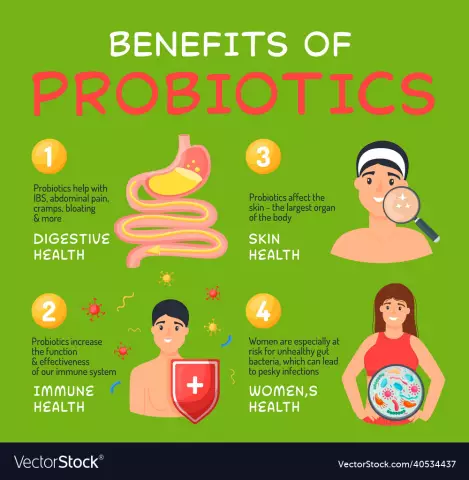- Author Rachel Wainwright [email protected].
- Public 2023-12-15 07:39.
- Last modified 2025-11-02 20:14.
Spazgan Neo
Spazgan Neo: instructions for use and reviews
- 1. Release form and composition
- 2. Pharmacological properties
- 3. Indications for use
- 4. Contraindications
- 5. Method of application and dosage
- 6. Side effects
- 7. Overdose
- 8. Special instructions
- 9. Application during pregnancy and lactation
- 10. Use in childhood
- 11. In case of impaired renal function
- 12. For violations of liver function
- 13. Use in the elderly
- 14. Drug interactions
- 15. Analogs
- 16. Terms and conditions of storage
- 17. Terms of dispensing from pharmacies
- 18. Reviews
- 19. Price in pharmacies
Latin name: Spasgan Neo
ATX code: M01AE51
Active ingredient: ibuprofen (Ibuprofen) + pitofenon (Pitofenone) + fenpiverinium bromide (Fenpiverinium bromide)
Producer: Wockhardt Limited (India)
Description and photo update: 2019-08-07
Prices in pharmacies: from 173 rubles.
Buy

Spazgan Neo is a combined drug with analgesic, antispasmodic and anti-inflammatory effects.
Release form and composition
Dosage form - tablets, film-coated: white, round biconvex shape, engraved W on one side (in a cardboard box 2 or 10 blisters of 10 tablets; in a cardboard box 6 plastic packages containing 1 blister of 6 tablets; each pack also contains instructions for using Spazgan Neo).
Composition of 1 tablet:
- active substances: ibuprofen - 400 mg; pitofenone (as hydrochloride) - 5 mg; fenpiverinium bromide - 0.1 mg;
- auxiliary components (core): croscarmellose sodium - 4.7 mg; talc - 5 mg; magnesium stearate - 5 mg; sodium lauryl sulfate - 2.4 mg; disodium edetate dihydrate - 0.6 mg; corn starch - 88 mg; alginic acid - 10.6 mg; povidone (PVP K-90) - 11 mg; colloidal silicon dioxide - 7 mg; microcrystalline cellulose - 85.9 mg; sodium carboxymethyl starch (type A) - 14.7 mg;
- film shell: Opadray II 85G68918 white: (macrogol - 2.1 mg; polyvinyl alcohol - 7.4 mg; talc - 3.36 mg; titanium dioxide - 5.76 mg; soy lecithin - 0.58 mg) - 19, 2 mg.
Pharmacological properties
Pharmacodynamics
Spazgan Neo is one of the combined drugs that have analgesic, antispasmodic and anti-inflammatory effects. The mechanism of action is based on the suppression of the synthesis of Pg (prostaglandins).
Spazgan Neo contains:
- ibuprofen: a non-steroidal anti-inflammatory drug derived from phenylpropionic acid. It has analgesic, anti-inflammatory and antipyretic effects. The main mechanism of influence is inhibition of the synthesis of Pg, which are modulators of pain sensitivity, inflammation and thermoregulation in peripheral tissues and the central nervous system. The use of ibuprofen in women with primary dysmenorrhea helps to reduce the increased level of Pg in the myometrium, thereby reducing the frequency of uterine contractions and intrauterine pressure;
- Pitofenone hydrochloride: myotropic antispasmodic agent; like papaverine, the substance has a direct relaxing effect on the smooth muscles of the internal organs and leads to the relief of spasms;
- fenpiverinium bromide: m-anticholinergic agent of central and peripheral action; due to the suppression of the excitation of m-choline-reactive structures, the substance has an additional relaxing effect on smooth muscles.
The combination of all active ingredients mutually enhances their pharmacological action.
Pharmacokinetics
All active ingredients of Spazgan Neo are well absorbed in the gastrointestinal tract. The peak plasma concentration in the blood is reached approximately 1-2 hours after ingestion.
Ibuprofen - the main component of Spazgan Neo, binds to blood plasma proteins at a level of 99%. The substance can accumulate in the synovial fluid, metabolism takes place in the liver.
Excretion is carried out in the urine (90% of the dose) in the form of conjugates and metabolites. A small part of the dose is excreted in the bile. The half-life from blood plasma is 120 minutes.
Indications for use
- pain syndrome of mild and moderate severity, which occurs with spasms of smooth muscles of internal organs, including with renal, biliary and intestinal colic, biliary dyskinesia;
- dysmenorrhea (gynecological diseases);
- headache, including migraine in nature;
- joint pain, neuralgia, sciatica, myalgia (short symptomatic treatment).
Contraindications
Absolute:
- renal failure (in patients with creatinine clearance less than 30 ml / min), progressive kidney disease;
- liver failure or active liver disease;
- active gastrointestinal bleeding, erosive and ulcerative changes in the mucous membrane of the stomach or duodenum;
- confirmed hyperkalemia;
- period of exacerbation of inflammatory bowel diseases, including ulcerative colitis;
- acute intermittent porphyria;
- granulocytopenia;
- the presence of anamnestic data on attacks of urticaria, bronchial obstruction, rhinitis after the use of acetylsalicylic acid or other nonsteroidal anti-inflammatory drug (complete / incomplete syndrome of acetylsalicylic acid intolerance, including rhinosinusitis, urticaria, nasal mucosa polyps, bronchial asthma);
- hemophilia and other blood clotting disorders including hypocoagulation, hemorrhagic diathesis;
- conditions after coronary artery bypass grafting;
- deficiency of glucose-6-phosphate dehydrogenase;
- disorders of hematopoiesis;
- angle-closure glaucoma;
- tachyarrhythmia;
- diseases of the optic nerve;
- intestinal obstruction;
- hyperplasia of the prostate;
- pregnancy and lactation;
- age under 16;
- individual intolerance to the components in Spazgan Neo.
Relative (Spazgan Neo is prescribed under medical supervision):
- impaired renal function (in patients with creatinine clearance of 30-60 ml / min);
- congestive heart failure;
- cerebrovascular diseases;
- arterial hypertension;
- cardiac ischemia;
- hyperbilirubinemia;
- hyperlipidemia / dyslipidemia;
- diabetes;
- nephrotic syndrome;
- a history of indication of gastric ulcer and duodenal ulcer;
- peripheral arterial disease;
- enteritis, gastritis, colitis;
- presence of Helicobacter pylori infection;
- smoking, alcoholism (frequent alcohol consumption);
- blood diseases of unknown etiology (anemia, leukopenia);
- severe somatic diseases;
- long-term therapy with non-steroidal anti-inflammatory drugs;
- combined use with the following drugs: anticoagulants, oral glucocorticosteroids, antiplatelet agents, selective serotonin reuptake inhibitors;
- elderly age.
Spazgan Neo, instructions for use: method and dosage
Spazgan Neo tablets are intended for oral administration.
The drug should be used 60 minutes before or 3 hours after a meal. To minimize irritation to the stomach, a single dose can be taken with milk or taken immediately after meals.
Unless otherwise prescribed by a doctor, for spastic pains, a single dose of Spazgan Neo is 1 tablet, maximum can be taken up to three times a day.
Without medical advice, the duration of taking Spazgan Neo should not exceed five days. If more prolonged therapy is needed, it should be carried out under the control of the functional state of the liver and indicators of the peripheral blood picture.
Side effects
In the case of using Spazgan Neo in recommended doses, side reactions usually do not develop.
Possible adverse reactions (> 10% - very common;> 1% and 0.1% and 0.01% and <0.1% - rarely; <0.01% - very rare):
- respiratory system: rarely - bronchospasm, shortness of breath;
- digestive system: often - gastropathy associated with the use of non-steroidal anti-inflammatory drugs (including abdominal pain, nausea, vomiting, heartburn, decreased appetite, diarrhea, constipation, flatulence); infrequently - ulceration of the mucous membrane of the gastrointestinal tract (in some cases, they can be complicated by bleeding and perforation), pain in the mouth, dryness and irritation of the oral mucosa, aphthous stomatitis, ulceration of the gingival mucosa; very rarely - hepatotoxicity, impaired liver function, pancreatitis, hepatitis;
- nervous system: infrequently - dizziness, headache, depression, drowsiness, anxiety, irritability, insomnia, nervousness, psychomotor agitation; very rarely - hallucinations, confusion, aseptic meningitis (more often against the background of autoimmune diseases);
- urinary system: infrequently - urine staining red, anuria, oliguria, nephrotic syndrome (edema), proteinuria, polyuria, cystitis; rarely - allergic nephritis, acute renal failure;
- cardiovascular system: infrequently - increased blood pressure, tachycardia; rarely - heart failure;
- organ of hearing: rarely - hearing impairment (including hearing loss, noise or ringing in the ears);
- organ of vision: infrequently - scotoma, blurred vision, irritation and dryness of the eye, amblyopia, edema of the eyelids and conjunctiva (allergic etiology); very rarely - toxic damage to the optic nerve, paresis of accommodation;
- hematopoietic organs: infrequently - thrombocytopenic purpura and thrombocytopenia; very rarely - agranulocytosis, eosinophilia, anemia (including hemolytic and aplastic), leukopenia;
- allergic reactions: infrequently - itchy skin, skin rash (usually erythematous or urticaria); very rarely - anaphylactoid reactions, Quincke's edema, fever, anaphylactic shock, dyspnoea or bronchospasm, exudative erythema multiforme (including Stevens-Johnson syndrome), allergic rhinitis, toxic epidermal necrolysis (Lyell's syndrome);
- laboratory parameters: an increase in bleeding time, serum creatinine concentration, hepatic transaminase activity, a decrease in serum glucose concentration, a decrease in creatinine clearance, hemoglobin or hematocrit;
- others: very rarely - decrease / increase in sweating.
Overdose
- main symptoms: metabolic acidosis, vomiting, nausea, abdominal pain, drowsiness, lethargy, headache, depression, tinnitus, coma, decreased blood pressure, tachycardia, bradycardia, acute renal failure, respiratory arrest, atrial fibrillation;
- therapy: gastric lavage (shown only for 60 minutes after taking Spazgan Neo), alkaline drink, activated charcoal, forced diuresis, symptomatic treatment (consists in correcting blood pressure, acid-base state).
If you take a dose of Spazgan Neo that exceeds the recommended dose, you should immediately consult a doctor or the nearest medical facility.
The specific antidote is unknown.
special instructions
If prolonged use of Spazgan Neo is indicated, it is necessary to monitor the functional state of the kidneys / liver and the picture of peripheral blood.
To reduce the likelihood of adverse reactions from the gastrointestinal tract, you need to take the lowest effective dose. If symptoms of gastropathy appear, careful monitoring is necessary, which includes a blood test with determination of hematocrit and hemoglobin, fecal occult blood test, EGDS (esophagogastroduodenoscopy).
You should refrain from taking alcohol during therapy.
If it is necessary to determine 17-ketosteroids, Spazgan Neo should be canceled 48 hours before the study.
Influence on the ability to drive vehicles and complex mechanisms
While using Spazgan Neo, you should refrain from driving.
Application during pregnancy and lactation
Spazgan Neo is not prescribed during pregnancy / lactation.
Pediatric use
For patients under 16 years of age, Spazgan Neo is contraindicated.
With impaired renal function
- renal failure (in patients with creatinine clearance less than 30 ml / min), progressive kidney disease: therapy is contraindicated;
- impaired renal function (in patients with creatinine clearance of 30-60 ml / min): Spazgan Neo should be used under medical supervision.
For violations of liver function
Liver failure or active liver disease are contraindications to the use of Spazgan Neo.
Use in the elderly
Spazgan Neo is prescribed for elderly patients under medical supervision.
Drug interactions
If Spazgan Neo is used in therapeutic doses, it does not enter into significant interactions with widely used drugs.
Possible interactions:
- inducers of microsomal oxidation enzymes in the liver (phenylbutazone, ethanol, phenytoin, barbiturates, rifampicin, flumecinol, tricyclic antidepressants): with combined use, an increase in the production of hydroxylated active metabolites is noted, which increases the likelihood of severe intoxication;
- inhibitors of microsomal oxidation: there is a decrease in the risk of hepatotoxic effects;
- vasodilators: their hypotensive activity decreases;
- m-anticholinergics, H 1 -histamine blockers, butyrophenones, phenothiazines, amantadine, quinidine: against the background of combined use, their therapeutic effect is enhanced;
- mineralocorticosteroids, glucocorticosteroids: their side reactions intensify, which increases the risk of gastrointestinal bleeding;
- furosemide, hydrochlorothiazide: there is a decrease in their natriuretic effect;
- indirect anticoagulants, antiplatelet agents, fibrinolytics: against the background of combined use, an increase in their action is observed, which leads to an increase in the likelihood of bleeding;
- digoxin, methotrexate, lithium preparations: their concentration in the blood increases;
- uricosuric drugs: their effectiveness decreases;
- estrogens, ethanol: their side effects are enhanced;
- cholestyramine, antacids: in combination therapy, reduce the absorption of ibuprofen;
- oral hypoglycemic agents: their therapeutic effect may be enhanced, which contributes to the risk of hypoglycemia;
- caffeine: enhances the analgesic (analgesic) effect of Spazgan Neo;
- non-steroidal anti-inflammatory drugs: combination therapy increases the incidence of side effects;
- acetylsalicylic acid: in the case of simultaneous use, its antiplatelet and anti-inflammatory effect is reduced, which contributes to an increase in the incidence of acute coronary insufficiency in patients who receive small doses of acetylsalicylic acid as an antiplatelet agent;
- valproic acid, cefamandol, cefotetan, cefoperazone, plikamycin: the incidence of hypoprothrombinemia increases;
- myelotoxic drugs: the manifestations of Spazgan Neo's hematotoxicity increase;
- cyclosporine: plasma concentration increases due to interaction with ibuprofen, which increases the likelihood of its hepatotoxic effects;
- gold preparations, cyclosporine: these drugs increase the effect of ibuprofen on the biosynthesis of prostaglandins in the kidneys, which leads to an increase in nephrotoxicity;
- drugs that block tubular secretion: due to their interaction with ibuprofen, its excretion decreases and plasma concentration increases.
Analogs
The analogues of Spazgan Neo are Brufika Plus, Brustan, Nurofen Long, Ibuklin Junior, Next, Novigan, Ibuklin, Khairumat, Teraflex Advance, etc.
Terms and conditions of storage
Store in a place protected from light and moisture at temperatures up to 25 ° C. Keep out of the reach of children.
The shelf life is 3 years.
Terms of dispensing from pharmacies
Available without a prescription.
Reviews about Spazgan Neo
On specialized forums and sites, there are no reviews about Spazgan Neo for today.
Price for Spazgan Neo in pharmacies
Approximate price for Spazgan Neo, film-coated tablets 400 mg + 5 mg + 0.1 mg, for 20 pcs. in the package is 157 rubles.
Spazgan Neo: prices in online pharmacies
|
Drug name Price Pharmacy |
|
Spazgan Neo 400 mg + 0.1 mg + 5 mg film-coated tablets 20 pcs. 173 r Buy |

Maria Kulkes Medical journalist About the author
Education: First Moscow State Medical University named after I. M. Sechenov, specialty "General Medicine".
Information about the drug is generalized, provided for informational purposes only and does not replace the official instructions. Self-medication is hazardous to health!






